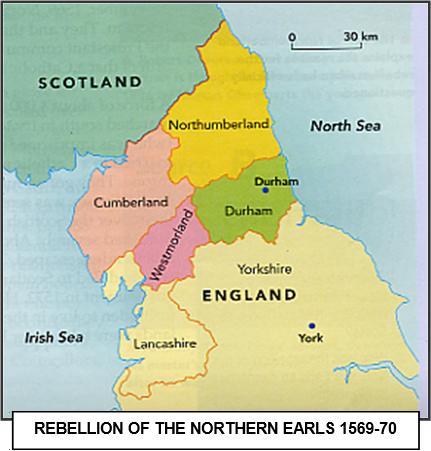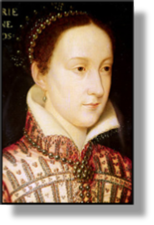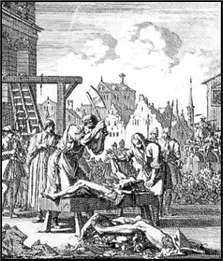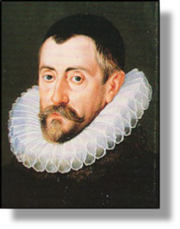


xxxxxDuring the reign of Elizabeth there were a number of Catholic conspiracies against her. Roman Catholics could not only call upon the support of Spain and France, but could also pin their hopes on the Roman Catholic Mary Queen of Scots, held a prisoner in England since 1568. They regarded her as the rightful queen. After a northern rebellion by Catholic nobles had been crushed in 1570, a Florentine merchant named Ridolfi, working in London, planned an invasion of England. In 1571 he gained the support of Pope Pius V, Philip II of Spain, and the Duke of Alva, governor general of the Spanish Netherlands, but the Ridolfi Plot was uncovered by the seaman John Hawkins. A major conspirator, the catholic Duke of Norfolk, was executed for treason, but Ridolfi managed to escape to Italy.
THE BABINGTON PLOT 1586 (L1)
Acknowledgements
Map (Northern
England): source unknown. Walsingham:
detail, portrait attributed to the court painter John de Critz the
Elder (c1551-
xxxxxThe Babington Plot of 1586 was but one of many Catholic conspiracies which attempted to overthrow Protestant Queen Elizabeth. The religious settlement she imposed was bitterly opposed by Protestant dissidents who felt that it did not go far enough along the road to reform, but it was equally threatened, and more dangerously so, by English Roman Catholics. They could not only call upon outside support from Spain and France should the opportunity arise, but they were also able to pin their hopes on the presence in England of the Roman Catholic Mary Queen of Scots. A cousin of the Queen and a grandniece of Henry VIII, she had fled from Scotland in 1568 and was being held a prisoner in all but name. In the eyes of the Catholics, she was the rightful queen of England.
 xxxxxThus long before the Babington Plot of 1586 there was evidence of growing Catholic unrest.
In 1569 a serious rebellion broke out in the North, led by
staunchly Catholic nobles (see map). It was put down with brutal
force. Then
two years later the Ridolfi Plot was uncovered. Thisxwas a
scheme hatched up by Roberto Ridolfi (1531-
xxxxxThus long before the Babington Plot of 1586 there was evidence of growing Catholic unrest.
In 1569 a serious rebellion broke out in the North, led by
staunchly Catholic nobles (see map). It was put down with brutal
force. Then
two years later the Ridolfi Plot was uncovered. Thisxwas a
scheme hatched up by Roberto Ridolfi (1531-
xxxxxThe plot
seemed all set to run, but it all went horribly wrong. A little
earlier the English seaman John Hawkins, having feigned sympathy
with the Catholic cause, had gained the confidence of the Spanish
ambassador in England and obtained details of the conspiracy. WhenxRidolfi's servant, one Charles
Baillie (1542-
xxxxxBoth the
Northern Rebellion and the Ridolfi Plot were almost certainly
linked to Mary Queen of Scots, an ambitious woman who was no
stranger to conspiracy. For Elizabeth, this posed a serious
political problem, but she continued to resist the pleas of
Parliament, and many of her counsellors -
Including:
The Ridolfi Plot,
The Throgmorton Plot
and Peter Bales

L1-
 xxxxxIt was against
this background that the Babington Plot
was hatched in 1586.
Anthony Babington of Derbyshire (1561-
xxxxxIt was against
this background that the Babington Plot
was hatched in 1586.
Anthony Babington of Derbyshire (1561-

xxxxxBabington then made a fatal mistake. He wrote to Mary telling her of his plans, but his letter and her reply were intercepted by Walsingham's spies. Ballard was seized and, doubtless under torture, betrayed his fellow conspirators. Babington tried to flee the country, but all the ports had been closed. He took refuge in a Roman Catholic convent in Harrow, just outside London, but in August he was discovered. He tried to put all the blame on Ballard, and begged the Queen for mercy, but to no avail. He was tried alongside Ballard and three others involved in the plot and all were found guilty of high treason. Babington was brutally executed in Lincoln's Inn Fields in September 1586 (illustrated).
xxxxxIt seems highly likely that the Babington Plot was, in fact, a carefully engineered trap, craftily set up by the government (i.e. Walsingham) in order to gain sufficient evidence to have Mary tried and executed for high treason. Whether this was so or not, the affair certainly ended up with that result. After much hesitation, Elizabeth signed Mary's death warrant, and she was beheaded in February 1587. Some have since argued that the evidence against Mary was not conclusive, dependent upon the interpretation of a postscript in her letter to Babington, but, given her track record, there can be little real doubt concerning her complicity.
 xxxxxIncidentally, it is known
that Walsingham used the services of an English calligrapher named
Peter Bales (1547-
xxxxxIncidentally, it is known
that Walsingham used the services of an English calligrapher named
Peter Bales (1547-
xxxxxA similar
attempt to bring about an invasion of England was made by the
staunch Catholic Francis Throgmorton (1554-
 xxxxxIt was about this time
that yet another conspiracy, the Throgmorton
Plot, was discovered. A staunch
Catholic, Francis Throgmorton (1554-
xxxxxIt was about this time
that yet another conspiracy, the Throgmorton
Plot, was discovered. A staunch
Catholic, Francis Throgmorton (1554-
xxxxxIt was
against this background that the Babington
Plot was hatched in 1586. Anthony Babington (1561-


